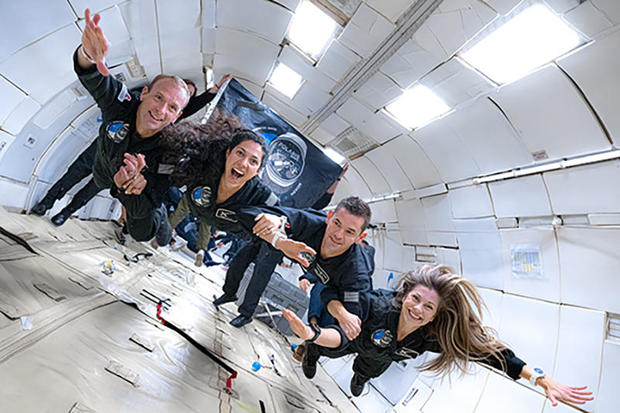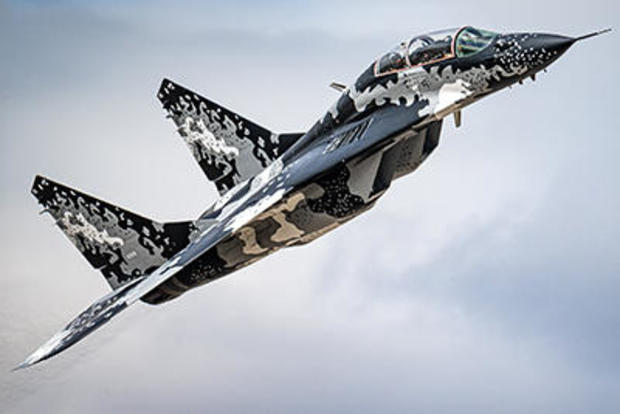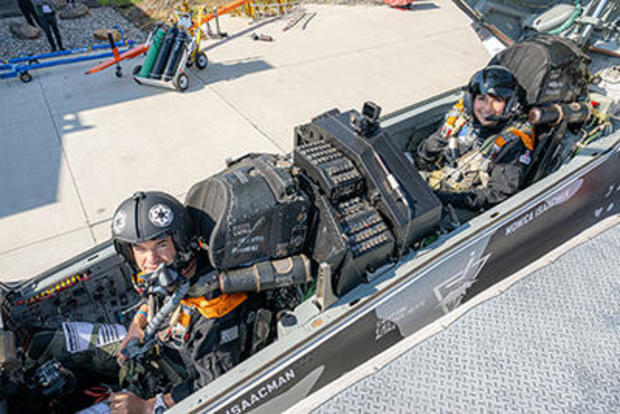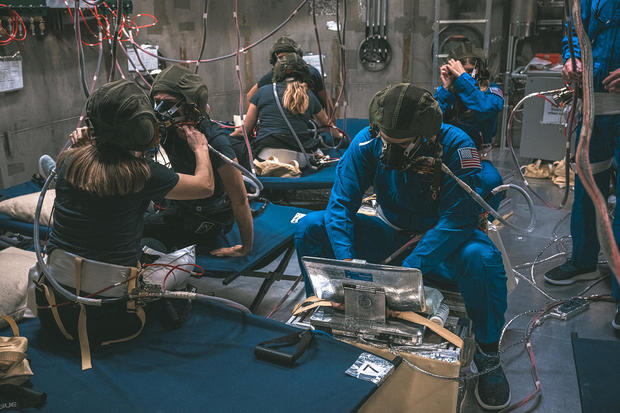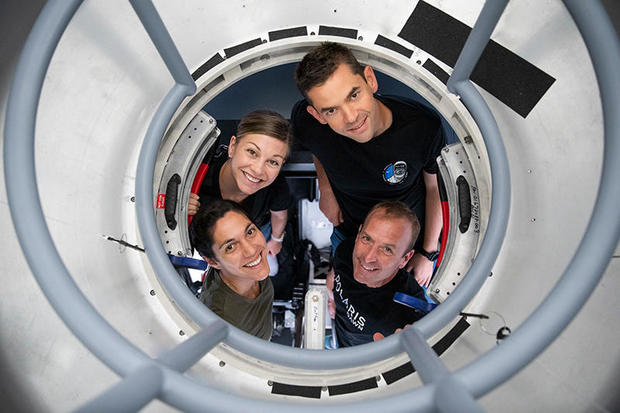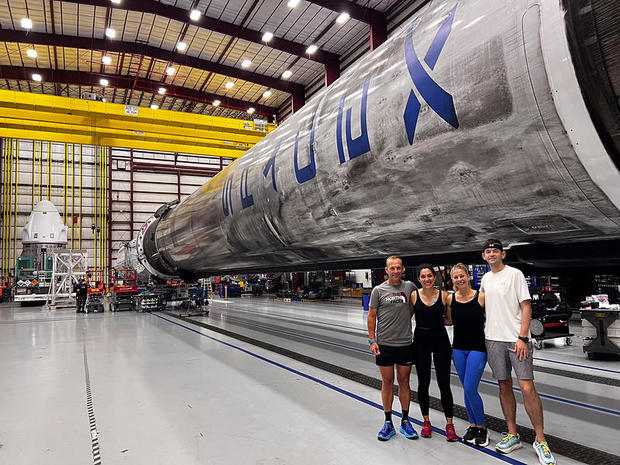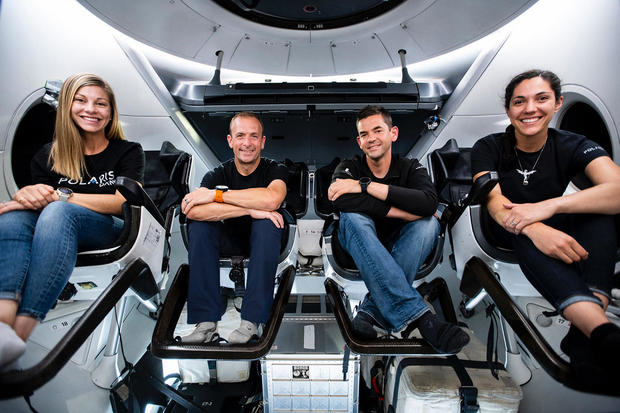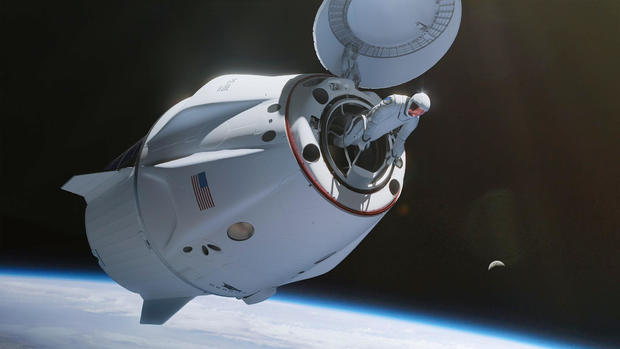
SpaceX to launch Polaris Dawn flight featuring billionaire crew member, first commercial spacewalk
Jared Isaacman, a billionaire adventurer and philanthropist who chartered the first commercial flight to orbit aboard a SpaceX Crew Dragon in 2021 plans to blast off with three crewmates on an even more daring flight Tuesday, this one featuring the first commercial spacewalks.
Wearing innovative SpaceX-designed suits and connected to their spacecraft by 12-foot-long umbilicals and safety tethers, Isaacman and SpaceX crew trainer Sarah Gillis will each spend about 15 minutes each just outside the ship’s forward hatch to put the suits through their paces.
SpaceX
Their two crewmates, former F-16 pilot Scott “Kidd” Poteet and Anna Menon, a SpaceX Crew Dragon mission director, will remain inside the cabin wearing their own spacesuits. The Crew Dragon is not equipped with an airlock, and the cabin will have to be vented down to vacuum before the ship’s hatch is opened to space.
https://t.co/eYQnMo1nrK— Elon Musk (@elonmusk) August 22, 2024
Over the course of the five-day mission, the crew also will test a high-tech laser communications link to Earth using Starlink internet satellites and carry out 36 mostly bio-medical experiments in partnership with 31 institutions.
The research includes “smart” contact lenses and other instruments to monitor changes in internal eyeball pressure in the absence of gravity, a possible contributor to degraded eyesight in long-duration fliers.
Other experiments focus on space motion sickness, balance and other vestibular issues, tests of an innovative ultrasound instrument and even an experiment to find out if the radiation inherent in the space environment is energetic enough to enable X-ray type imaging.
Isaacman’s first SpaceX flight — Inspiration4 — raised more than $250 million for St. Jude Children’s Research Hospital. Likewise, the Polaris Dawn flight also will benefit the famed Memphis hospital. Frito-Lay, for example, is giving $500,000 to St. Jude’s and putting out limited edition Dorito “zero gravity flavored tortilla chips” for those who make a donation.
Polaris Dawn
“Life is short, and you only have so much time to make as much of an impact as you possibly can,” said Isaacman, who founded what became the widely used payment processing company Shift4 when he was 16 years old. “Supporting SpaceX and St. Jude both, which have unbelievable visions, is some of the best use of my time and energy.
“There are cool objectives, for sure, the altitude, the spacewalk. But really, there’s such a bigger picture to that, which is trying to open up access to this last frontier and keep learning. I think we stand to learn an awful lot, and I want to help contribute to it.”
The Polaris Dawn mission is the first of three planned by Isaacman, who owns and pilots his own MiG-29 fighter jet, in cooperation with Musk. The second flight will be another Crew Dragon mission while the third will be the first piloted flight of SpaceX’s huge Super Heavy-Starship rocket, now under development in Texas.
It’s not known how much Isaacman might be paying for the flights or how much SpaceX is funding on its own. Asked at a news conference if he could share any details, Isaacman said “not a chance.”
In any case, the crew strapped into their Crew Dragon capsule atop a Falcon 9 rocket early Sunday and worked through a dress-rehearsal countdown. Three hours after the crew departed, SpaceX engineers test fired the first stage booster’s nine Merlin 1D engines to verify their readiness for flight.
Polaris Dawn
Polaris Dawn
That set the stage for launch from historic pad 39A at the Kennedy Space Center at 3:38 a.m. EDT Tuesday, one day later than originally planned. The Falcon 9 will climb away on a northeasterly trajectory tilted 51.6 degrees to the equator, the same orbital inclination used by astronauts heading to the International Space Station.
Following a 12-minute climb to space, the Crew Dragon will be released to fly on its own in an initial orbit with a high point, or apogee, of 745 miles and a low point, or perigee, of just 118 miles. The International Space Station, in contrast, flies in a circular orbit at an altitude of about 260 miles.
As the crew checks out the Crew Dragon’s systems, flight controllers will start a carefully planned, 45-hour process to boost oxygen levels in the cabin while slowly decreasing air pressure to help remove nitrogen from the crew’s bloodstreams.
The goal of the lengthy “pre-breathe” protocol is to prevent the bends, or decompression sickness, after the spacewalk on flight day three when all four transition from the 5 pounds per square inch pressure in their suits back up to the normal 14.6 psi cabin pressure.
“We don’t anticipate experiencing (the bends), because a ton of robust preparation has gone into developing this pre-breathe protocol, significantly reducing that risk,” said Menon, a former biomedical flight controller for NASA who is married to a NASA astronaut. “But we’re prepared if we need it.”
Polaris Dawn
Following spacecraft checkout shortly after reaching orbit, the Crew Dragon’s thrusters will fire to boost the apogee up to 870 miles, a new record for an Earth-orbit mission. Menon and Gillis will be farther from Earth than any of the 94 women launched into space before them.
As the spacecraft passes through the high-altitude portion of each orbit, it will fly through a denser population of space debris than it will at the low point of the trajectory. By sticking to a highly elliptical orbit, the crew will lower the odds of an impact to a more acceptable level, roughly comparable to a lower-altitude circular orbit.
Another unusual factor: the crew will be exposed to higher radiation levels from the Van Allen belts, vast clouds of charged particles captured from the solar wind by Earth’s magnetic field. The Van Allen belts start at an altitude of roughly 400 miles and extend out to 36,000 miles or so.
The Apollo astronauts passed through the Van Allen belts on the way to the moon and the Polaris Dawn crew will fly through their lower reaches. But researchers say Isaacman’s crew will receive roughly the same radiation dosage during their five days in space as a space station crew gets during less than half of a normal six-month stay in orbit.
In any case, the Crew Dragon will only spend about 10 hours in that extremely elliptical orbit. After that, the ship’s thrusters will fire again to lower the apogee to 435 miles. The ship will stay in that orbit for the spacewalk on flight day three and for the research the crew plans to carry out for the rest of the mission.
Assuming an on-time launch Tuesday, the crew will rehearse spacewalk procedures the next day, donning their pressure suits and verifying all systems are go.
“We’ll get pressurized in the suits and actually go through a mobility demo where we step through the sequence and movements inside the spacecraft and really make sure there was nothing missed in our training, that we’re confident before we step outside,” Gillis said.
Polaris Dawn
The Crew Dragon does not have an airlock and its life support system was not designed to support spacewalks. Required modifications included “adding a lot more oxygen to the spacecraft so that we can feed oxygen to four suits through umbilicals for the full duration of the spacewalk,” Gillis said.
“There have been upgrades and additions to the environmental sensing suite in the spacecraft to make sure we have really good insight, both before, during and after exposure to vacuum. And … an entirely new system, a nitrogen repress system” to boost the cabin back up to normal pressure after the spacewalk.
A new ladder-like mobility aid, known as the “Skywalker,” is in place above the ship’s upper hatch, providing Isaacman and Gillis multiple handholds and footholds, and a motor drive system was added to assist with hatch opening and closing. Upgraded seals are in place to ensure an airtight fit.
All of that will be put to the test overnight Wednesday and into Thursday when the crew puts their spacesuits back on and the cabin is vented down to vacuum. After final checks, Isaacman will open the ship’s upper hatch, exposing the crew to the space environment.
Isaacman and Gillis will take turns floating just outside the hatch, using the Skywalker for support, spending about 15 minutes each testing the comfort and flexibility of their pressurized suits. They will remain connected to the Crew Dragon by 12-foot-long safety tethers and umbilicals.
From vacuum inside the Crew Dragon to cabin re-pressurization, the exercise is expected to take about two hours.
NASA astronaut Ed White carried out the first U.S. spacewalk on June 3, 1965, floating free of his Gemini 4 capsule at the end of a long tether. Isaacman said iconic photos of White floating against the backdrop of Earth and space were inspirational, but he and Gillis will not float free of the Crew Dragon. And that’s by design.
“We’re not going to be doing the Ed White float,” Isaacman told CBS News. “That might look cool, but it doesn’t really help SpaceX learn a lot about the performance (of the spacesuit). It’s not very useful or helpful for figuring out how to be able to to work in a suit.”
Polaris Dawn
To that end, he and Gillis will work through a “matrix” of planned motions to get a feel for how the suit’s multiple joints move while pressurized, to test the performance of an innovative heads-up display in the helmet, better understand how the air-cooled suits deal with the extreme temperatures of space and a variety of other factors.
The suit “includes all sorts of technology, including a heads-up display, a helmet camera, an entirely new architecture for joint mobility,” Gillis said. “There’s thermal insulation throughout the suit, including a copper and indium tin oxide visor that both provides thermal protection and solar protection.”
In addition, she said, “there’s all sorts of redundancy, both in the oxygen supply feed to the suit, as well as all of the valves, all of the seals across the suit. It’s an incredible suit.”
The heads-up display, which will project critical data on the lower left side of the helmet visor, is a feature NASA’s decades old space station suits do not have.
“During the EVA, we’ll have insight into our suit, pressure, temperature, relative humidity and then also an understanding of how much oxygen we’ve used throughout the EVA. So some key pieces of telemetry right there. And it’s it’s really cool (that) with any lighting you can still see it.”
The spacewalk will be live streamed by SpaceX using cameras inside and outside the crew cabin that are expected to provide dramatic shots “to share with the world,” she said.
While Isaacman and Gillis take turns floating just above the Crew Dragon’s hatch, Poteet and Menon will monitor the tethers connected to their crewmates’ suits, preventing any snags or tangles while keeping tabs on the Crew Dragon’s systems, ready to assist if needed.
Polaris Dawn
“I see our role as the eyes and ears for them,” Menon said. “We are supporting them, helping make sure that this whole team executes the spacewalk safely and successfully, and so at least contributing to that, being a part of the larger team doing that.
“They’re attached to the vehicle via long umbilicals that allow them to get their gas supply as well as their communications and that kind of thing. And so we’ll be making sure that doesn’t get caught on anything, helping them navigate the internal environment if they can’t see something, for example, and just being a part supporting them.”
Once Gillis wraps up her turn and is back inside the Crew Dragon, the hatch will be closed and the cabin will be re-pressurized.
The day after the spacewalk, flight controllers plan to test a new laser link with SpaceX’s constellation of Starlink internet satellites in low-Earth orbit to relay communications to and from Earth. The laser is mounted in the lower trunk section of the Crew Dragon.
“This is pretty cool,” Isaacman said. “It is no small task to have two objects going 17,500 miles an hour,communicating over a beam of light. But it has the opportunity to open up an entirely new communication pathway, not just for Dragon but for armadas of Starships or other satellites or telescopes out there, and kind of free up some of the burden on the existing (satellite) and ground station infrastructure.”
The rest of the Polaris Dawn mission will be devoted to completing the planned bio-medical research before setting up for re-entry and splashdown off the coast of Florida.
Bill Gerstenmaier, former director of space operations at NASA who now serves as SpaceX’s vice president of Build and Flight Reliability, said the California rocket builder builds “off of what we learned from NASA in some ways, and then we push it a little bit further in other areas.”
And the pace of that innovation is striking.
“This pace of development that we get to do at SpaceX is very much like the pace of development that was required back in the early Apollo days,” Gerstenmaier said. “We’re getting a chance to do that again, where we’re really starting to push frontiers with the private sector and learning new things that we would not be able to learn by staying in the risk-free environment of here on Earth.
“It’s time to go out, it’s time to explore,” he said. “It’s time to do these big things and move forward.”
More
More
Source: cbsnews.com
